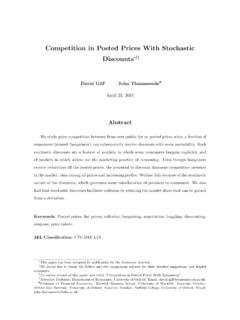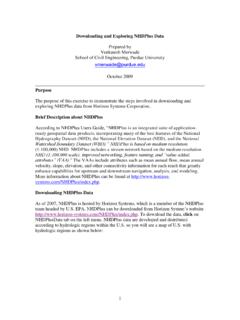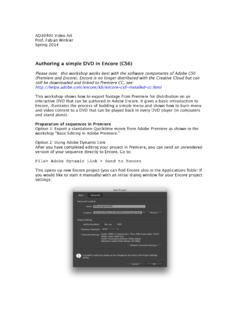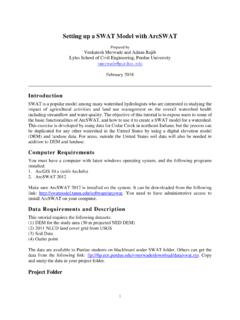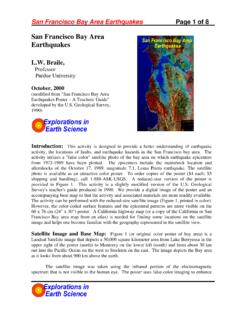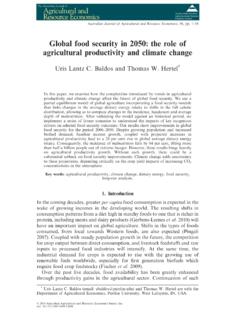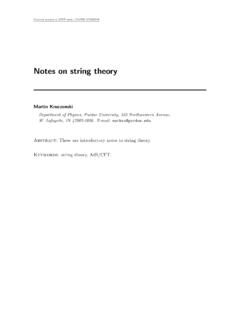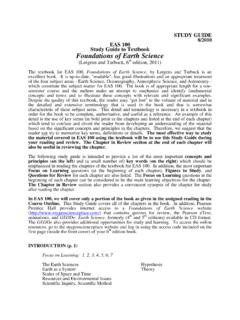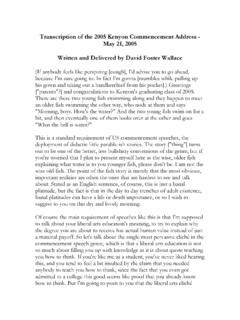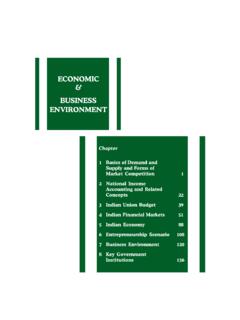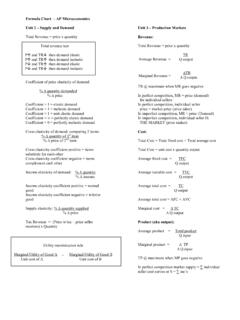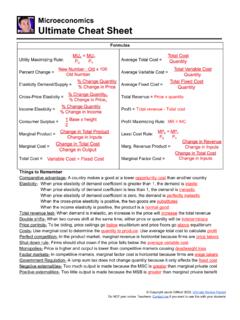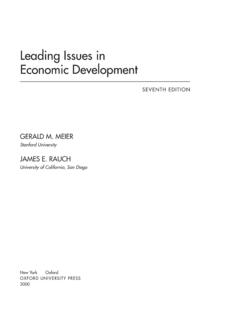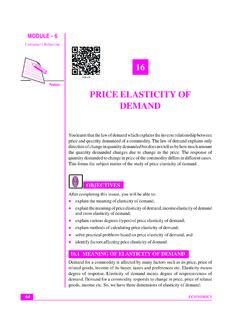Transcription of Basic Regression with Time Series Data - Purdue University
1 Basic Regression with Time Series Data ECONOMETRICS (ECON 360). BEN VAN KAMMEN, PHD. Introduction This chapter departs from the cross-sectional data analysis, which has been the focus in the preceding chapters. Instead of observing many ( n ) elements in a single time period, time Series data are generated by observing a single element over many time periods. The goal of the chapter is broadly to show what can be done with OLS using time Series data. Specifically students will identify similarities in and differences between the two applications and practice methods unique to time Series models. Outline The Nature of Time Series Data. Stationary and Weakly Dependent Time Series . Asymptotic Properties of OLS. Using Highly Persistent Time Series in Regression Analysis. Examples of (Multivariate) Time Series Regression Models.
2 Trends and Seasonality. The nature of time Series data Time Series observations have a meaningful order imposed on them, from first to last, in contrast to sorting a cross-section alphabetically or by an arbitrarily assigned ID number. The values are generated by a stochastic process, about which assumptions can be made, , the mean, variance, covariance, and distribution of the innovations (also sometimes called disturbances or shocks) that move the process forward through time. The nature of time Series data (continued). So an observation of a time Series , , ; 0, .. , , where is the sample size, can be thought of as a single realization of the stochastic process. Were history to be repeated, many other realizations for the path of would be possible. Owing to the randomness generating the observations of y, the properties of OLS that depend on random sampling still hold.
3 The econometrician's job is to accurately model the stochastic process, both for the purpose of inference as well as prediction. Prediction is an application for time Series model estimates because knowing the process generating new observations of y naturally enables you to estimate a future ( out of sample ) value. Stationary and weakly dependent time Series Many time Series processes can be viewed either as regressions on lagged (past) values with additive disturbances or as aggregations of a history of innovations. In order to show this, we have to write down a model and make some assumptions about how present values of y ( ) are related to past values ( , 1 ) and about the variance and covariance structure of the disturbances. For the sake of clarity, consider a univariate Series that does not depend on values of other variables only on lagged values of itself.
4 Stationary and weakly dependent time Series (continued). = 1 1 + ; = 0, 2 = 2 , = 0, is a simple example of such a model. Specifically this is an autoregressive process of order 1 more commonly called AR(1) for brevity . because y depends on exactly 1 lag of itself. In this instance we have also assumed that the disturbances have constant (zero) mean and variance and are not correlated across time periods. In order to make use of a Series in Regression analysis, it needs to have an expected value, variance, and auto-covariance (covariance with lagged values of itself), though, and not all Series have these (at least not that are finite). A Series will have these properties if it is stationary. Stationarity The property of stationarity implies: 1 is independent of , 2 is a finite positive constant, independent of , 3 , is a finite function of , but not or , 4 The distribution of is not changing over time.
5 For our purposes the 4th condition is unnecessary, and a process that satisfies the first 3 is still weakly stationary or covariance stationary. Stationarity of AR(1) process The AR(1) process, , is covariance stationary under specific conditions. = 1 1 + ; 1 = 1 = 0, = 2 = 12 1. 2. + = 12 2 + 2 , 2.. 2 = 2. 1 1. This is only finite if 1 is less than one in absolute value. Otherwise the denominator goes to zero and the variance goes to infinity. 2.. 2 = 2 ; 1 < 1. 1 1. Using highly persistent time Series in Regression analysis Even if the weak dependency assumption fails, , 1 = 1, an autoregressive process can be analyzed using a (1st difference) transformed OLS model, which makes a non-stationary, strongly dependent process stationary. The differences in the following process (called a random walk ) are stationary.
6 = 1 1 + 1 = , has a finite mean and variance (distribution) that does not depend on t. The Wooldridge book contains more information on testing whether a Series has this kind of persistence (see pp. 396-399 and 639-644) and selecting an appropriate transformation of the Regression model, but these topics are left to the interested student as optional. Stationarity of AR(1) process (continued). The covariance between two observations that are h periods apart is: + = 2 1 . This auto-covariance does not depend on either of the two places in the time Series only on how far apart they are. To derive this, one needs to iteratively substitute for +1 : +1 = 1 1 1 + + +1 ; +2 = 1 [ 12 1 + 1 + +1 ] + +2 . With careful inspection, a pattern emerges as you continue substituting.. + = 1 +1 1 + 1 +.
7 =0. More on this derivation. Stationarity of AR(1) process (concluded). How persistent the Series is depends on how close to one 1 is in absolute value. The closer it is, the more persistent are the values in the Series . It is also worth noting how the persistence dies out when the gap (h) between the observations is large. This should confirm the intuition that observations with more time intervening between them will be less correlated. Before moving on, let's summarize a couple more things about the iterative substitution of the AR(1) process. Autocorrelation concluded The current period's value can be expressed neatly as an infinitely long summation of the past disturbances ( history ).. = 1 , and =0. the process can accommodate a constant as well, , . 0. = 0 + 1 1 + = 1 0 + ; = . 1 1.
8 =0. Though many variables exhibit no more than 1 order of autocorrelation, it is conceivable to have p orders, , . = 0 + + , is AR(p). =1. Asymptotic properties of OLS. The assumptions about autoregressive processes made so far lead to disturbances that are contemporaneously exogenous if the parameters were to be estimated by OLS. This set (next slide) of assumptions leads to Theorem , which is that OLS estimation of a time Series is consistent. An AR process, for example, will still be biased in finite samples, however, because it violates the stronger Assumption (that all disturbances are uncorrelated with all regressors not just the contemporary one). More on the biasedness of OLS. Conditions under which OLS on time Series data is consistent 1. Assumption ' states that the model is linear in parameters (appears in the text in Chapter 10 as ), the process is stationary, and weakly dependent ( , +.)
9 0 as h gets large). 2. Assumption ' (same as ) states that the regressors (lagged values) have variation (are not constants) nor are perfectly collinear (functions of other regressors). 3. Assumption ' states that the current period's disturbance is mean independent of the regressors, , the lagged values of . = 0;. is the set of regressors: either lagged values of y or other independent variables, as in cross-sectional analysis. Asymptotic properties of OLS. (concluded). Under additional Assumptions about the disturbances, inference according to the usual tests is valid: 4. Assumption ' is the analog of the homoskedasticity assumption: | = = 2 , which is called contemporaneous homoskedasticity. 5. And Assumption ' rules out serial correlation in the disturbances: , | , = 0| 0. Examples of (multivariate) time Series Regression models There are numerous time Series applications that involve multiple variables moving together over time that this course will not discuss: the interested student should study Chapter 18.
10 But bringing the discussion of time Series data back to familiar realms, consider a simple example in which the dependent variable is a function of contemporaneous and past values of the explanatory variable. Models that exhibit this trait are called finite distributed lag (FDL) models. Finite distributed lag models This type is further differentiated by its order, , how many lags are relevant for predictingy. An FDL of order q is written: = 0 + 0 + 1 1 +.. + + , or compactly as, . = 0 + + . =0. Note that this contains the Static Model, , in which = 0| > 0, as a special case. Applications are numerous. the fertility (responds to tax code incentives to have children) example in the text exemplifies short run and long run responses to a market shock. Finite distributed lag models (continued).
